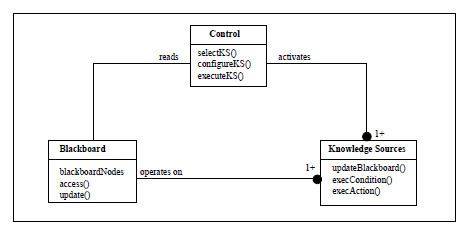 | ||
In software engineering, the blackboard pattern is a behavioral design pattern that provides a computational framework for the design and implementation of systems that used to integrate large and diverse specialised modules. It also implements complex, non deterministic control strategies.
Contents
This pattern has been identified by the members of the HEARSAY-II project and first applied for speech recognition.
Structure
The blackboard model defines three main components:
Implementation
First step is to design the solution space (i.e. various solutions) that leads to the definition of blackboard structure. Then, knowledge source are to be identified. These two activities are very related.
The next step is to specify the control component that is generally in the form of a complex scheduler that makes use of a set of domain-specific heuristics to rate the relevance of executable knowledge sources.
Known Uses
Some usage-domains are:
Consequences
The blackboard pattern provides effective solutions for designing and implementing complex systems where heterogeneous modules have to be dynamically combined to solve a problem. This provides properties such as:
Blackboard pattern allows multiple processes to work closer together on separate threads, polling, and reacting, if it is needed.
Example
Sample radar defense system is provided as an example (in CSharp).
Code for MainWindow.xaml:
Code for item container for positioning
Code for Item (ItemTemplate defines the object, an Image and TextBoxes):
Code behind the Blackboard component in MVVM ViewModel implementation:
Code behind the Controller:
Code for the base class IObject:
Code in the radar module:
Code to handle incoming object:
Code for knowledge source interface:
implementation for signal processor:
code segments for copying between writablebitmaps:
Code for comparing pixel in image recognition:
Code for plane identification:
Code for the war machine:
